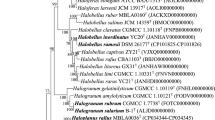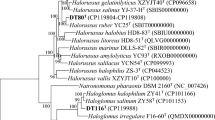Abstract
The genera Haloarcula and Halomicroarcula are the most closely related genera within the family Haloarculaceae (class Halobacteria). The respective 16S rRNA genes of type strains from the genus Haloarcula showed 94.7–96.5% similarities to their homologous genes of type strains from the genus Halomicroarcula. The Haloarcula species showed 89.3–92.8% rpoB′ gene similarities to Halomicroarcula species. These similarities were higher than the proposed genus boundary. Phylogenomic analysis revealed that these two genera formed a tight cluster separated from Halomicrobium with high bootstrap confidence. The average amino acid identity (AAI) values among Haloarcula and Halomicroarcula were 70.1–74.5%, higher than the cutoff value (67.0%) to differentiate the genera Haloarcula and Halomicroarcula from Halomicrobium. These results indicated that the genus Halomicroarcula should be merged with Haloarcula. Then, six novel species are described based on strains DFY41T, GDY20T, SHR3T, XH51T, YJ-61-ST, and ZS-22-S1T isolated from coarse sea salt, marine solar saltern, and salt lake (China). These six strains formed separate clades (90.1–99.3% 16S rRNA and 89.0–94.9% rpoB′ gene similarities) and then clustered with current Haloarcula and Halomicroarcula species (89.4–99.1% 16S rRNA and 87.6–95.0% rpoB′ gene similarities), as revealed by phylogenetic analyses. The average nucleotide identity (ANI), digital DNA-DNA hybridization (dDDH), and AAI values among these six strains and current Haloarcula and Halomicroarcula species were 76.2–89.8%, 25.3–46.0%, and 70.3–89.7%, respectively, clearly below the species demarcation threshold. These six strains were distinguished from current Haloarcula and Halomicroarcula species according to differential phenotypic characteristics. Six novel species, Haloarcula halophila sp. nov., Haloarcula litorea sp. nov., Haloarcula rara sp. nov., Haloarcula halobia sp. nov., Haloarcula pelagica sp. nov., and Haloarcula ordinaria sp. nov., are proposed to accommodate strains DFY41T, GDY20T, SHR3T, XH51T, YJ-61-ST, and ZS-22-S1T, respectively.



Similar content being viewed by others
Data availability
The sequences determined in this study were deposited and available in the NCBI GenBank.
References
Aziz RK, Bartels D, Best AA, DeJongh M, Disz T, Edwards RA, Formsma K, Gerdes S, Glass EM, Kubal M, Meyer F, Olsen GJ, Olson R, Osterman AL, Overbeek RA, McNeil LK, Paarmann D, Paczian T, Parrello B, Pusch GD, Reich C, Stevens R, Vassieva O, Vonstein V, Wilke A, Zagnitko O (2008) The RAST Server: rapid annotations using subsystems technology. BMC Genomics 9:75. https://doi.org/10.1186/1471-2164-9-75
Barreteau H, Vandervennet M, Guédon L, Point V, Canaan S, Rebuffat S, Peduzzi J, Carré-Mlouka A (2019) Haloarcula sebkhae sp. nov., an extremely halophilic archaeon from Algerian hypersaline environment. Int J Syst Evol Microbiol 69:732–738. https://doi.org/10.1099/ijsem.0.003211
Chen F, Xu Y, Sun S, Shi X, Liu A, Chen S (2020) Halomicroarcula amylolytica sp. nov., a novel halophilic archaeon isolated from a salt mine. Int J Syst Evol Microbiol 70:4978–4985. https://doi.org/10.1099/ijsem.0.004368
Chun J, Oren A, Ventosa A, Christensen H, Arahal DR, da Costa MS, Rooney AP, Yi H, Xu X-W, De Meyer S, Trujillo ME (2018) Proposed minimal standards for the use of genome data for the taxonomy of prokaryotes. Int J Syst Evol Microbiol 68:461–466. https://doi.org/10.1099/ijsem.0.002516
Cui H-L, Zhou P-J, Oren A, Liu S-J (2009) Intraspecific polymorphism of 16S rRNA genes in two halophilic archaeal genera, Haloarcula and Halomicrobium. Extremophiles 13:31–37. https://doi.org/10.1007/s00792-008-0194-2
Cui H-L, Gao X, Yang X, Xu X-W (2010) Halorussus rarus gen. nov., sp. nov., a new member of the family Halobacteriaceae isolated from a marine solar saltern. Extremophiles 14:493–499. https://doi.org/10.1007/s00792-010-0329-0
Cui C, Han D, Hou J, Cui H-L (2023) Genome-based classification of the class Halobacteria and description of Haladaptataceae fam. nov. and Halorubellaceae fam. nov. Int J Syst Evol Microbiol 73:005984. https://doi.org/10.1099/ijsem.0.005984
de la Haba RR, Minegishi H, Kamekura M, Shimane Y, Ventosa A (2021) Phylogenomics of haloarchaea: the controversy of the genera Natrinema-Haloterrigena. Front Microbiol 12:740909. https://doi.org/10.3389/fmicb.2021.740909
Durán-Viseras A, Sánchez-Porro C, Ventosa A (2021) Genomic insights into new species of the genus Halomicroarcula reveals potential for new osmoadaptative strategies in halophilic archaea. Front Microbiol 12:751746. https://doi.org/10.3389/fmicb.2021.751746
Dussault HP (1955) An improved technique for staining red halophilic bacteria. J Bacteriol 70:484–485. https://doi.org/10.1128/jb.70.4.484-485.1955
Echigo A, Minegishi H, Shimane Y, Kamekura M, Itoh T, Usami R (2013) Halomicroarcula pellucida gen. nov., sp. nov., a non-pigmented, transparent-colony-forming, halophilic archaeon isolated from solar salt. Int J Syst Evol Microbiol 63:3556–3562. https://doi.org/10.1099/ijs.0.049965-0
Enomoto S, Shimane Y, Ihara K, Kamekura M, Itoh T, Ohkuma M, Takahashi-Ando N, Fukushima Y, Yoshida Y, Usami R, Takai K, Minegishi H (2020) Haloarcula mannanilytica sp. nov., a galactomannan-degrading haloarchaeon isolated from commercial salt. Int J Syst Evol Microbiol 70:6331–6337. https://doi.org/10.1099/ijsem.0.004535
Felsenstein J (1981) Evolutionary trees from DNA sequences: a maximum likelihood approach. J Mol Evol 17:368–376. https://doi.org/10.1007/BF01734359
Han D, Cui H-L (2020) Halostella pelagica sp. nov. and Halostella litorea sp. nov., isolated from salted brown alga Laminaria. Int J Syst Evol Microbiol 70:1969–1976. https://doi.org/10.1099/ijsem.0.004003
Ihara K, Watanabe S, Tamura T (1997) Haloarcula argentinensis sp. nov. and Haloarcula mukohataei sp. nov., two new extremely halophilic archaea collected in Argentina. Int J Syst Bacteriol 47:73–77. https://doi.org/10.1099/00207713-47-1-73
Juez G, Rodriguez-Valera F, Ventosa A, Kushner DJ (1986) Haloarcula hispanica spec. nov. and Haloferax gibbonsii spec. nov., two new species of extremely halophilic archaebacteria. Syst Appl Microbiol 8:75–79. https://doi.org/10.1016/S0723-2020(86)80152-7
Kanehisa M, Goto S, Kawashima S, Okuno Y, Hattori M (2004) The KEGG resource for deciphering the genome. Nucleic Acids Res 32:D277-280. https://doi.org/10.1093/nar/gkh063
Kim M, Oh HS, Park SC, Chun J (2014) Towards a taxonomic coherence between average nucleotide identity and 16S rRNA gene sequence similarity for species demarcation of prokaryotes. Int J Syst Evol Microbiol 64:346–351. https://doi.org/10.1099/ijs.0.059774-0
Li X-X, Tan S, Cheng M, Hu Y, Ma X, Hou J, Cui H-L (2023) Salinilacihabitans rarus gen. nov., sp. nov., Natrononativus amylolyticus gen. nov., sp. nov., Natronobeatus ordinarius gen. nov., sp. nov., and Halovivax gelatinilyticus sp. nov., halophilic archaea, isolated from a salt lake and soda lakes. Extremophiles 27:15. https://doi.org/10.1007/s00792-023-01303-5
Luo C, Rodriguez-R LM, Konstantinidis KT (2014) MyTaxa: an advanced taxonomic classifier for genomic and metagenomic sequences. Nucleic Acids Res 42:e73. https://doi.org/10.1093/nar/gku169
Ma X, Hu Y, Li X-X, Tan S, Cheng M, Hou J, Cui H-L (2023) Halomicroarcula laminariae sp. nov. and Halomicroarcula marina sp. nov., extremely halophilic archaea isolated from salted brown alga Laminaria and coastal saline-alkali lands. Int J Syst Evol Microbiol 73:005889. https://doi.org/10.1099/ijsem.0.005889
Meier-Kolthoff JP, SardàCarbasse J, Peinado-Olarte RL, Göker M (2022) TYGS and LPSN: a database tandem for fast and reliable genome-based classification and nomenclature of prokaryotes. Nucleic Acid Res 50:D801–D807. https://doi.org/10.1093/nar/gkab902
Minegishi H, Kamekura M, Itoh T, Echigo A, Usami R, Hashimoto T (2010) Further refinement of the phylogeny of the Halobacteriaceae based on the full-length RNA polymerase subunit B’ (rpoB’) gene. Int J Syst Evol Microbiol 60:2398–2408. https://doi.org/10.1099/ijs.0.017160-0
Minh BQ, Schmidt HA, Chernomor O, Schrempf D, Woodhams MD, von Haeseler A, Lanfear R (2020) IQ-TREE 2: New models and efficient methods for phylogenetic inference in the genomic era. Mol Biol Evol 37:1530–1534. https://doi.org/10.1093/molbev/msaa015
Namwong S, Tanasupawat S, Kudo T, Itoh T (2011) Haloarcula salaria sp. nov. and Haloarcula tradensis sp. nov., isolated from salt in Thai fish sauce. Int J Syst Evol Microbiol 61:231–236. https://doi.org/10.1099/ijs.0.021790-0
Oren A, Ginzburg M, Ginzburg BZ, Hochstein LI, Volcani BE (1990) Haloarcula marismortui (Volcani) sp. nov., nom. rev., an extremely halophilic bacterium from the Dead Sea. Int J Syst Bacteriol 40:209–210. https://doi.org/10.1099/00207713-40-2-209
Oren A, Ventosa A, Grant WD (1997) Proposed minimal standards for description of new taxa in the order Halobacteriales. Int J Syst Evol Microbiol 47:233–238. https://doi.org/10.1099/00207713-47-1-233
Oren A, Arahal DR, Ventosa A (2009) Emended descriptions of genera of the family Halobacteriaceae. Int J Syst Evol Microbiol 59:637–642. https://doi.org/10.1099/ijs.0.008904-0
Parks DH, Chuvochina M, Waite DW, Rinke C et al (2018) A standardized bacterial taxonomy based on genome phylogeny substantially revises the tree of life. Nat Biotechnol 36:996–1004. https://doi.org/10.1038/nbt.4229
Richter M, Rosselló-Móra R, Olive GF (2016) JSpeciesWS: a web server for prokaryotic species circumscription based on pairwise genome comparison. Bioinformatics 32:929–931. https://doi.org/10.1093/bioinformatics/btv681
Siakotos AN, Rouser G (1965) Analytical separation of nonlipid water soluble substances and gangliosides from other lipids by dextran gel column chromatography. J Am Oil Chem Soc 42:913–919. https://doi.org/10.1007/BF02632444
Sun Y-P, Wang B-B, Zheng X-W, Wu Z-P, Hou J, Cui H-L (2022) Description of Halosolutus amylolyticus gen. nov., sp. nov., Halosolutus halophilus sp. nov. and Halosolutus gelatinilyticus sp. nov., and genome-based taxonomy of genera Natribaculum and Halovarius. Int J Syst Evol Microbiol 72:005598. https://doi.org/10.1099/ijsem.0.005598
Sun Y-P, Wang B-B, Wu Z-P, Zheng X-W, Hou J, Cui H-L (2023) Halorarius litoreus gen. nov., sp. nov., Halorarius halobius sp. nov., Haloglomus halophilum sp. nov., Haloglomus salinum sp. nov., and Natronomonas marina sp. nov., extremely halophilic archaea isolated from tidal flat and marine solar salt. Front Mar Sci 10:1105929. https://doi.org/10.3389/fmars.2023.1105929
Takashina T, Hamamoto T, Otozai K, Grant WD, Horikoshi K (1990) Haloarcula japonica sp. nov., a new triangular halophilic archaebacterium. Syst Appl Microbiol 13:177–181. https://doi.org/10.1016/S0723-2020(11)80165-7
Tamura K, Stecher G, Peterson D et al (2013) MEGA6: molecular evolutionary genetics analysis version 6.0. Mol Biol Evol 30:2725–2729. https://doi.org/10.1093/molbev/mst197
Tao C-Q, Ding Y, Zhao Y-J, Cui H-L (2020) Natronorubrum halophilum sp. nov. isolated from two inland salt lakes. J Microbiol 58:105–112. https://doi.org/10.1007/s12275-020-9514-8
Torreblanca M, Rodriguez-Valera F, Juez G, Ventosa A, Kamekura M, Kates M (1986) Classification of non-alkaliphilic halobacteria based on numerical taxonomy and polar lipid composition, and description of Haloarcula gen. nov. and Haloferax gen. nov. Syst Appl Microbiol 8:89–99. https://doi.org/10.1016/S0723-2020(86)80155-2
Vaskovsky VE, Kostetsky EY (1968) Modified spray for the detection of phospholipids on thin-layer chromatograms. J Lipid Res 9:396. https://doi.org/10.1016/S0022-2275(20)43111-6
Wang B-B, Bao C-X, Sun Y-P, Hou J, Cui H-L (2023) Halobacterium wangiae sp. nov. and Halobacterium zhouii sp. nov., two extremely halophilic archaea isolated from sediment of a salt lake and saline soil of an inland saltern. Int J Syst Evol Microbiol 73:005922. https://doi.org/10.1099/ijsem.0.005922
Xu L, Dong Z, Fang L, Luo Y, Wei Z, Guo H, Zhang G, Gu YQ, Coleman-Derr D, Xia Q, Wang Y (2019) OrthoVenn2: a web server for whole-genome comparison and annotation of orthologous clusters across multiple species. Nucleic Acids Res 47(W1):W52–W58. https://doi.org/10.1093/nar/gkz333
Yang Y, Cui H-L, Zhou P-J, Liu S-J (2007) Haloarcula amylolytica sp. nov., an extremely halophilic archaeon isolated from Aibi salt lake in Xin-Jiang, China. Int J Syst Evol Microbiol 57:103–106. https://doi.org/10.1099/ijs.0.64647-0
Yarza P, Yilmaz P, Pruesse E, Glöckner FO, Ludwig W, Schleifer KH, Whitman WB, Euzéby J, Amann R, Rosselló-Móra R (2014) Uniting the classification of cultured and uncultured bacteria and archaea using 16S rRNA gene sequences. Nat Rev Microbiol 12:635–645. https://doi.org/10.1038/nrmicro3330
Yoon S-H, Ha S-M, Kwon S, Lim J, Kim Y, Seo H, Chun J (2017) Introducing EzBioCloud: a taxonomically united database of 16S rRNA gene sequences and whole-genome assemblies. Int J Syst Evol Microbiol 67:1613–1617. https://doi.org/10.1099/ijsem.0.001755
Zhang W-J, Cui H-L (2014) Halomicroarcula limicola sp. nov., isolated from a marine solar saltern, and emended description of the genus Halomicroarcula. Int J Syst Evol Microbiol 64:1747–1751. https://doi.org/10.1099/ijs.0.062455-0
Acknowledgements
We are grateful to the graduated students (Xing-Xing Qiu, Xiao-Yan Yang, and Pan-Pan Yuan, Master’s degree), for their primary contribution to this study.
Funding
This work was financially supported by the National Natural Science Foundation of China (No. 32070003), and the National Science and Technology Fundamental Resources Investigation Program of China (No. 2019FY100700; No. 2021FY100900).
Author information
Authors and Affiliations
Corresponding authors
Ethics declarations
Conflict of interest
No competing interest exists.
Ethical approval
The article does not contain any study related to human participants or animals.
Additional information
Communicated by Oren.
Publisher's Note
Springer Nature remains neutral with regard to jurisdictional claims in published maps and institutional affiliations.
Supplementary Information
Below is the link to the electronic supplementary material.
Rights and permissions
Springer Nature or its licensor (e.g. a society or other partner) holds exclusive rights to this article under a publishing agreement with the author(s) or other rightsholder(s); author self-archiving of the accepted manuscript version of this article is solely governed by the terms of such publishing agreement and applicable law.
About this article
Cite this article
Ma, X., Hu, Y., Li, XX. et al. Genome-based taxonomy of genera Haloarcula and Halomicroarcula, and description of six novel species of Haloarcula. Extremophiles 28, 10 (2024). https://doi.org/10.1007/s00792-023-01329-9
Received:
Accepted:
Published:
DOI: https://doi.org/10.1007/s00792-023-01329-9




